Wet Room Bathroom: The Benefits & Beauty of Full Waterproofing
Author: Rick Worst | Editor: Omar Alonso
Review & Research: Jen Worst & Chris Miller
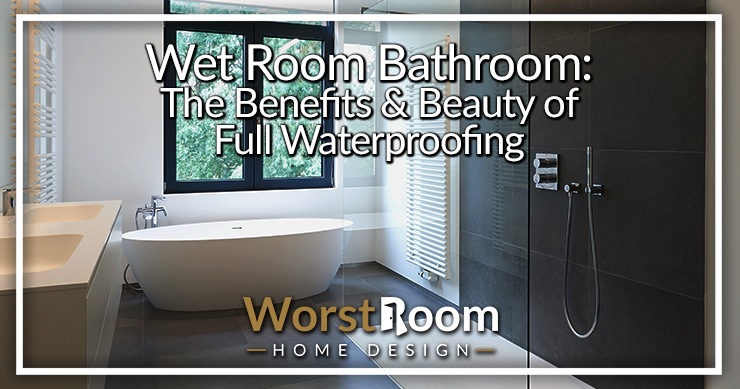
Are you looking to elevate your bathroom experience with a luxurious and modern touch? A wet room bathroom might be just what you need! With an open layout, sleek design, and seamless waterproofing features, wet rooms provide homeowners with the ultimate spa-like retreat.
In recent years, these stunning spaces have gained popularity for their minimalist aesthetic and practical functionality. Join us as we delve into the world of wet room bathrooms - exploring their benefits, essential design elements, maintenance tips, and more.
What Is a Wet Room Bathroom?
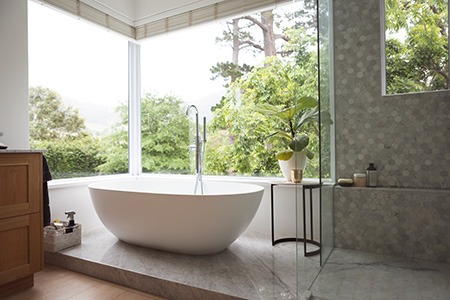
A wet room bathroom is a completely waterproofed space that combines both the shower and bathroom area, typically without any form of enclosure or tray to create an open-concept design.
Definition & Key Design Features
A wet room bathroom is a modern and elegant solution for those looking to maximize their space and create a sleek, minimalist design. Typically, this type of bathroom features an open concept layout without clear divisions between the shower, tub, sink, and toilet areas.
The floor-level shower offers a barrier-free experience as there's no need for a tray or door.
Natural materials like wood, stone, and concrete are often used in wet room bathrooms' designs. The walls and floors are sealed against water using specialized waterproofing methods to prevent leakage into other parts of your home.
Additionally, this space-saving option comes with practical benefits - wall-hung toilets free up valuable real estate on your bathroom floor while contributing to easy cleaning and improved hygiene overall.
Comparison With Traditional Bathrooms
One key difference between wet room bathrooms and traditional bathrooms lies in the layout and design of the shower area. In a conventional bathroom, separate enclosures or barriers like shower curtains or glass doors are often used to confine water within the designated bathing space.
On the other hand, wet room bathrooms eliminate these barriers by integrating a walk-in shower seamlessly into the overall bathroom design. The floor slopes gently towards an inconspicuous floor drain, ensuring any water is efficiently removed without spreading throughout your entire bathroom.
This open-concept layout delivers not only an ultra-modern aesthetic but also enhances functionality by creating a sense of spaciousness that tile installation can complement with visually appealing patterns and textures.
Benefits of Having a Wet Room Bathroom
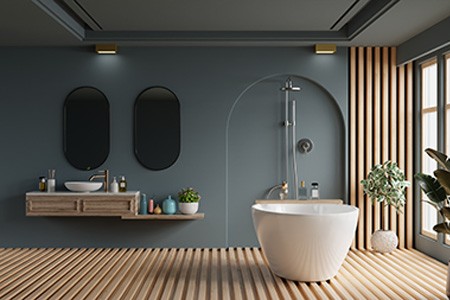
A wet room bathroom offers increased accessibility and safety, space-saving solutions, stylish design options, easy maintenance, and improved hygiene – continue reading to discover how these benefits could transform your bathroom into a haven of relaxation.
Increased Accessibility & Safety
A wet room bathroom is designed with accessibility and safety in mind, making it an excellent choice for individuals of all ages and mobility levels. The lack of shower trays or barriers, often referred to as barrier-free showers, eliminates the need to step or climb over a high edge while entering the shower area.
In addition to barrier-free entryways, wet rooms often feature non-slip flooring materials that provide extra traction underfoot. These surfaces help ensure stable footing even when wet, further contributing to the overall safety within the space.
Moreover, installing grab bars near showers offers additional support for older adults or anyone experiencing balance issues.
Space-Saving Solution
Wet room bathrooms are a great solution for those who want to maximize the space in their homes. Unlike traditional bathrooms, wet rooms have fewer walls and barriers, which creates an open and spacious feel.
This design option can be particularly useful when you're working with a small property or limited floor space.
In addition to being a space-saving solution, wet rooms are also perfect for those who require accessible features in their home. Wet rooms provide level floor access which makes it easy to move around without any tripping hazards such as shower trays or steps.
They are therefore more ideal especially if there's anyone with mobility issues living in your home.
Stylish & Versatile Design Options
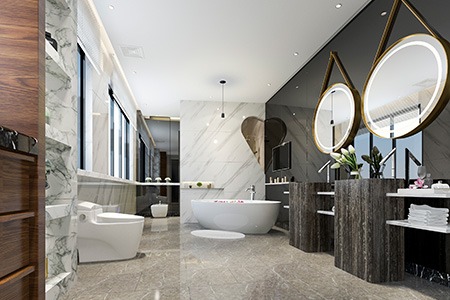
One of the biggest advantages of having a wet room bathroom is the increased design options it provides. With an open-concept layout, you have more freedom to create a unique and stylish space that reflects your personality and taste.
You can choose from a variety of materials such as natural stone, tiles or concrete, which are not only durable but also add visual interest to your bathroom.
The versatility provided by wet rooms allows homeowners to explore different design possibilities while still maintaining functionality. For example, if you have limited mobility, incorporating grab bars or non-slip flooring ensures safety without sacrificing style.
The large tiled area in wet rooms means they're great at accommodating various fixtures like rain showerheads while providing ample space compared to traditional bathrooms.
Easy to Clean & Maintain
One of the biggest benefits of having a wet room bathroom is that it's incredibly easy to keep clean. Unlike traditional bathrooms with their cramped enclosures, wet rooms have open spaces that allow for easier cleaning and maintenance.
Cleaning aside, maintaining a wet room bathroom is also relatively simple. Because there are no separate shower components or grout lines to worry about sealing or resealing over time, the upkeep on your wet room should be less intensive than traditional baths. Grout is waterproof as long as you maintain it, though.
Improved Hygiene
One of the key benefits of having a wet room bathroom is improved hygiene. The waterproof flooring and wall systems make it easy to clean, reducing the chances of mold and mildew buildup that can lead to health issues.
Moreover, wet rooms provide an excellent alternative for people with limited mobility or disabilities as they offer a barrier-free environment that makes it easier to move around without tripping over thresholds or ledges.
This not only reduces the risk of falls but also provides more space for caregivers to assist individuals while maintaining privacy.
Tips for Designing Your Own Wet Room Bathroom
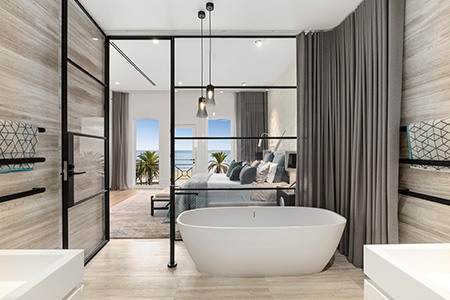
When designing your own wet room bathroom, consider the right waterproofing materials, drainage options, lighting and ventilation choices to ensure a functional and stylish space that's easy to maintain - keep reading for all the details!
Choosing the Right Materials for Wet Rooms
When designing a wet room bathroom, it is important to choose the right materials to ensure its longevity and function. One of the most critical factors when choosing materials for your wet room is waterproofing.
The floor material must be slip-resistant, durable, non-porous, and water-resistant to avoid accidents.
In addition to tiles, consider using other water-resistant surfaces like cement or marble sheets. Choose plumbing fixtures made from stainless steel or brass since these materials have excellent corrosion-resistance properties that can withstand long-term exposure to moisture.
It's paramount also to invest in high-quality sealants for all joints and gaps in your bathroom design; this will prevent water from leaking through these areas over time.
Waterproofing & Drainage Considerations
Waterproofing and proper drainage are two of the most important considerations in designing a wet room bathroom. The entire space, including the walls and floors, should be waterproofed to prevent leaks and water damage.
Drainage is equally crucial in wet room design as it prevents standing water that may lead to slips and falls. To ensure effective drainage, the floor must be sloped towards a central drain properly.
Tiling plays an essential role here because all tiles must slope slightly towards the drain with no gaps between them, preventing any water from seeping through. Concealing pipework beneath the tiles is also advisable for aesthetic purposes while avoiding potential leakage risks.
Lighting & Ventilation Options
When it comes to designing a wet room bathroom, lighting and ventilation are important factors to consider. Adequate lighting is essential for safety while showering or navigating the space, but choosing the right fixtures and bulbs is crucial as wet rooms have specific electrical requirements.
It's recommended to use wet-rated lights installed away from water sources inside the shower area.
Good ventilation in your wet room bathroom is essential for preventing mold and mildew growth that can occur due to excess moisture buildup. Installing a standard vent fan can help promote proper airflow by reducing humidity levels in the space.
In addition, proper waterproofing materials should be used during installation to prevent water leakage into walls or floors that could cause structural issues over time.
Maintenance & Care for Your Wet Room Bathroom
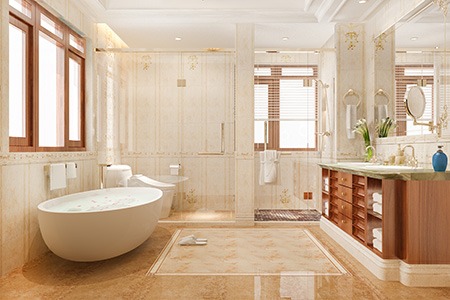
Maintaining and caring for your wet room bathroom is easy with a few simple steps. Firstly, ensure that the ventilation is clean by wiping down the extractor fan at least twice a year to prevent mold and mildew growth.
Secondly, use gentle bathroom cleaners that contain no harsh chemicals to avoid damaging water-resistant flooring or shower screens.
Another tip for maintaining a wet room bathroom is to develop a maintenance schedule so you can keep on top of cleaning and repairs before they become bigger problems. For example, scheduling monthly deep cleans where you scrub tiles and grout lines can save time in the long run by preventing buildup that's harder to remove later on.
In conclusion, owning a wet room bathroom means less overall cleaning but still requires some regular upkeep to maintain its functionality and aesthetics.
Key Takeaways Regarding a Wet Room Bathroom
- A wet room bathroom is a modern and stylish design that offers increased accessibility, safety, versatility, and easy maintenance.
- Unlike traditional bathrooms, wet rooms have fewer walls and barriers with open - concept layouts that can be particularly useful when working with a small property or limited floor space.
- When designing a wet room bathroom, it's important to choose the right waterproofing materials while prioritizing drainage considerations to prevent leaks and water damage. Proper lighting and ventilation are also crucial aspects of creating functional spaces.
Everything to Know About a Wet Room Bathroom
In conclusion, a wet room bathroom is a modern and stylish design choice that offers increased accessibility, safety, versatility, and easy maintenance. With proper waterproofing materials and drainage considerations in place, it can transform any bathroom into a luxurious spa-like experience. However, it's important to weigh the pros and cons of a wet room before deciding if it's the right option for your home.



